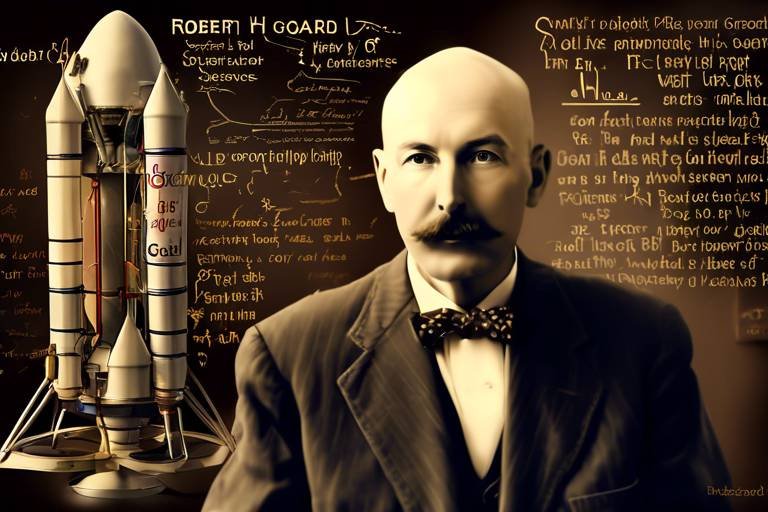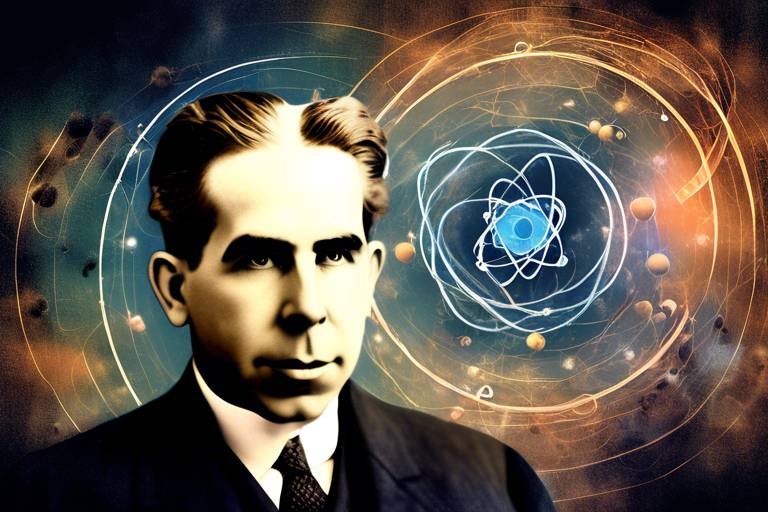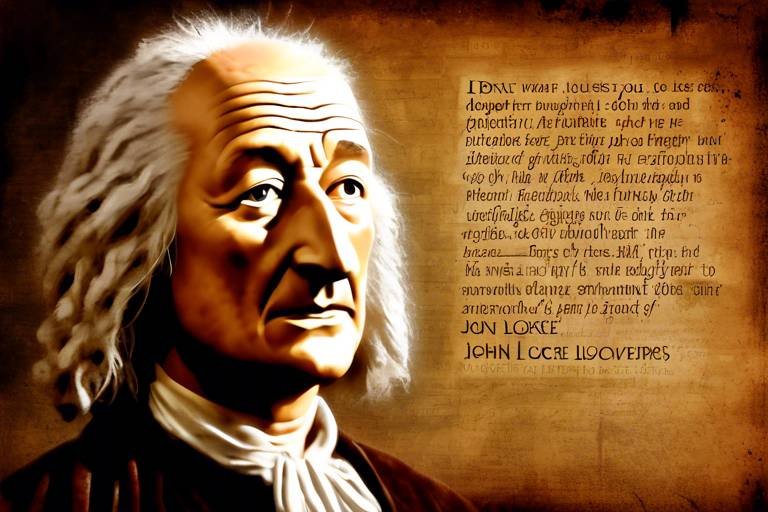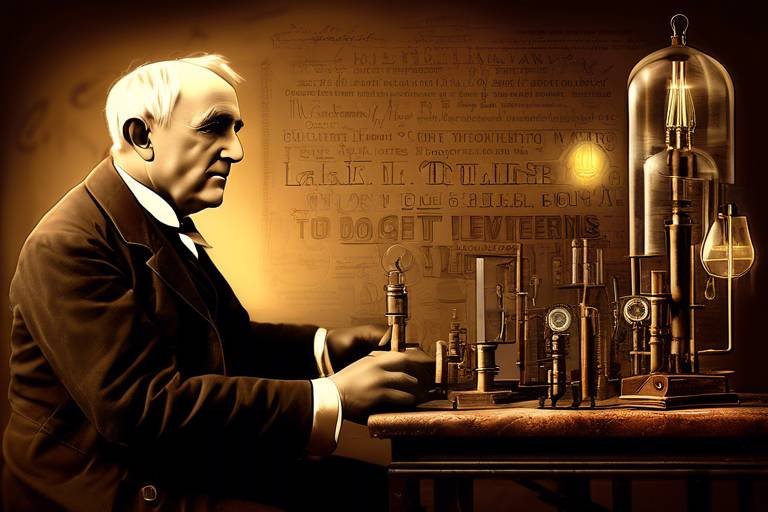The Work of John Dalton and Atomic Theory
This article explores the significant contributions of John Dalton to atomic theory, detailing his experiments, concepts of atoms, and the impact of his work on modern chemistry.
John Dalton was an English chemist and physicist whose pioneering work laid the foundation for modern atomic theory, revolutionizing our understanding of matter and its composition. Born in 1766 in a small village in England, Dalton's curiosity about the natural world was evident from a young age. He was not just a scientist; he was a visionary who dared to think differently. His journey into the world of atoms began when he started to explore the properties of gases and the nature of chemical reactions. Dalton's work was like a key turning in a lock, opening the door to a new understanding of what matter truly is.
Dalton's atomic theory proposed that all matter is composed of atoms, indivisible and indestructible particles, which combine in specific ratios to form compounds, fundamentally changing the field of chemistry. Imagine atoms as tiny building blocks; just as Lego bricks can be assembled in countless ways to create different structures, atoms combine in unique arrangements to form everything around us. This idea was revolutionary at the time, challenging the prevailing theories and setting the stage for future scientific exploration.
The key postulates of Dalton's atomic theory include the indivisibility of atoms, the uniqueness of each element's atoms, and the conservation of mass in chemical reactions, which remain essential to chemistry today. Dalton's insights were not just theoretical; they were backed by observation and experimentation. Let's break down these postulates:
- Indivisibility of Atoms: Atoms cannot be divided into smaller particles.
- Unique Atomic Weights: Each element has its own unique atomic weight.
- Conservation of Mass: In a chemical reaction, the total mass of reactants equals the total mass of products.
Dalton's assertion that atoms are indivisible was groundbreaking, suggesting that chemical reactions involve rearrangements of these tiny particles rather than their transformation into other substances. This idea challenged the notion that matter could be infinitely divided and helped lay the groundwork for the modern understanding of chemical reactions.
Dalton introduced the idea that each element has a unique atomic weight, which allowed for the classification of elements and the understanding of how they combine in chemical reactions. This concept was akin to assigning a unique fingerprint to each element, making it easier for scientists to predict how different elements would interact. For instance, knowing that hydrogen has a lower atomic weight than oxygen helps us understand why water is formed when they combine.
Dalton's contributions significantly influenced the development of modern chemistry, providing a framework that guided future research and experimentation in atomic structure and chemical bonding. His work inspired countless scientists to delve deeper into the world of atoms, leading to discoveries that have shaped our understanding of the universe. Without Dalton's foundational theories, the periodic table and quantum mechanics as we know them today might not exist.
Dalton's atomic theory was supported by various experiments, including gas laws and the law of multiple proportions, which demonstrated the consistent behavior of gases and the ratios in which elements combine. His ability to connect theory with experimental evidence is what set him apart from many of his contemporaries.
The gas laws, particularly Boyle's and Charles's laws, provided empirical evidence for Dalton's ideas about the behavior of gases and the role of atoms in forming gas mixtures. These laws describe how gases behave under different conditions, reinforcing the idea that gases are made up of tiny particles that interact in predictable ways.
This law states that when two elements form more than one compound, the ratios of the masses of one element that combine with a fixed mass of the other can be expressed as small whole numbers. This principle not only supports Dalton's atomic theory but also illustrates the beauty of chemistry, where relationships between elements can be expressed in simple numerical terms.
John Dalton's legacy endures in the field of chemistry, as his atomic theory laid the groundwork for future discoveries, including the development of the periodic table and quantum mechanics. His work is a testament to the power of curiosity and the pursuit of knowledge. Just as a seed grows into a mighty tree, Dalton's ideas have blossomed into a vast field of study that continues to evolve. Today, we stand on the shoulders of giants like Dalton, exploring the intricate world of atoms and molecules that make up everything we see around us.
- What did John Dalton discover? Dalton discovered the atomic theory, which states that all matter is composed of atoms, indivisible particles that combine in specific ratios to form compounds.
- Why is Dalton's atomic theory important? Dalton's atomic theory is important because it laid the groundwork for modern chemistry, influencing future research and the development of the periodic table.
- What are the key postulates of Dalton's atomic theory? The key postulates include the indivisibility of atoms, the uniqueness of atomic weights for each element, and the conservation of mass in chemical reactions.

Introduction to John Dalton
John Dalton was an English chemist and physicist whose pioneering work laid the foundation for modern atomic theory, revolutionizing our understanding of matter and its composition. Born on September 6, 1766, in Eaglesfield, England, Dalton's early life was marked by a keen interest in science and mathematics. His journey into the world of chemistry began in earnest when he started teaching at a local school, where he also conducted experiments and began to formulate his ideas about the nature of matter.
Dalton's passion for understanding the fundamental building blocks of the universe led him to propose revolutionary ideas that would change the landscape of chemistry forever. Imagine a time when the concept of atoms was merely a philosophical idea rather than a scientific fact. Dalton took it upon himself to change that perception. He viewed atoms as the small, indivisible particles that make up everything around us, from the air we breathe to the food we eat. This was not just a theoretical notion; Dalton's work was grounded in careful observation and experimentation, which he meticulously documented.
His seminal work, *A New System of Chemical Philosophy*, published in two volumes in 1808, outlined his atomic theory, which proposed that:
- All matter is composed of atoms.
- Atoms are indivisible and indestructible.
- Each element has its unique type of atom.
- Atoms combine in specific ratios to form compounds.
These ideas were not just groundbreaking; they were the spark that ignited the field of modern chemistry. Dalton's atomic theory provided a systematic way to understand chemical reactions and the composition of substances, leading to the development of new methodologies in chemical research. His work was instrumental in establishing a scientific basis for the classification of elements, which would later evolve into the periodic table.
In summary, John Dalton's contributions to atomic theory were crucial in shaping the future of chemistry. His innovative thinking and rigorous approach to scientific inquiry opened the door for countless discoveries and laid the groundwork for the scientific advancements that followed. Today, we owe much of our understanding of chemical processes and atomic structure to Dalton's relentless pursuit of knowledge and his belief in the power of atoms.

Dalton's Atomic Theory
When we dive into the world of chemistry, one name stands out like a beacon: John Dalton. His atomic theory is not just a collection of ideas; it’s a revolutionary framework that changed how we perceive the very fabric of matter. Imagine a world where everything around you, from the air you breathe to the food you eat, is made up of tiny, indivisible particles called atoms. Dalton proposed that all matter is composed of these atoms, which are not only indivisible but also indestructible. This was a radical shift from previous theories that suggested matter could be broken down indefinitely.
At the heart of Dalton's theory lies the concept that atoms combine in specific ratios to form compounds. This idea is akin to a recipe where each ingredient is measured precisely to create a delicious dish. If you think about it, just as a chef must follow a recipe to achieve the perfect flavor, atoms must combine in certain ways to form the substances we encounter in our daily lives. Dalton's theory brought a sense of order to the chaotic world of chemistry, allowing scientists to predict how different substances would interact based on their atomic composition.
Dalton outlined several key postulates that form the backbone of his atomic theory, which include:
- All matter is made up of atoms, which are indivisible and indestructible.
- Atoms of a given element are identical in mass and properties.
- Atoms of different elements differ in mass and properties.
- Atoms combine in simple whole-number ratios to form compounds.
- In a chemical reaction, atoms are rearranged, but neither created nor destroyed.
These postulates were groundbreaking at the time and laid the groundwork for future discoveries in chemistry. They provided a framework that guided scientists in understanding chemical reactions and the nature of substances. Dalton's emphasis on the uniqueness of each element's atoms was particularly significant, as it allowed for the classification of elements based on their atomic weights. This concept was a precursor to the development of the periodic table, which we now use to organize and understand the elements.
In essence, Dalton's atomic theory was like a key that unlocked the mysteries of matter. It gave scientists a new lens through which to examine the world, leading to a deeper understanding of chemical bonding and interactions. The implications of his work were profound, influencing not only chemistry but also physics and biology, as the concept of atoms became fundamental in various scientific disciplines.

Key Postulates of Dalton's Theory
John Dalton's atomic theory is often regarded as the cornerstone of modern chemistry, and it comprises several key postulates that fundamentally changed our understanding of matter. At its core, Dalton's theory asserts that all matter is made up of atoms, which are indivisible and indestructible particles. This notion was revolutionary at the time and laid the groundwork for future scientific inquiry.
One of the most significant aspects of Dalton's theory is the idea that each element consists of unique atoms. This means that the atoms of different elements have distinct properties and weights. For instance, the atomic weight of hydrogen is different from that of oxygen, which is crucial for understanding how these elements interact and combine to form compounds. Dalton's insights into atomic weights allowed chemists to classify elements systematically, paving the way for the development of the periodic table.
Another essential postulate of Dalton's theory is the conservation of mass during chemical reactions. Dalton proposed that when a chemical reaction occurs, atoms are neither created nor destroyed; rather, they are merely rearranged. This principle is not only fundamental to chemistry but also reflects the idea that the total mass of reactants equals the total mass of products in a reaction. To illustrate this concept, consider the following table that summarizes Dalton's key postulates:
| Postulate | Description |
|---|---|
| Indivisibility of Atoms | Atoms cannot be divided into smaller particles. |
| Unique Atomic Weights | Each element has its own unique atomic weight. |
| Conservation of Mass | Mass is conserved in chemical reactions; atoms are rearranged, not created or destroyed. |
Dalton's theory also emphasized the concept of compound formation. He proposed that atoms combine in fixed ratios to form compounds, which can be represented by chemical formulas. This idea of fixed ratios is crucial for understanding stoichiometry in chemical reactions, as it allows chemists to predict how substances will react based on their atomic compositions. For example, water (H2O) is formed by the combination of two hydrogen atoms and one oxygen atom, illustrating how Dalton's principles apply to real-world chemical interactions.
In summary, Dalton's key postulates serve as a foundational framework for modern chemistry. They not only explain the composition and behavior of matter but also guide the scientific community in exploring the complexities of atomic interactions. Dalton's work continues to resonate in contemporary research, reminding us of the importance of understanding the fundamental building blocks of the universe.
- What is Dalton's atomic theory?
Dalton's atomic theory posits that all matter is composed of indivisible atoms, each unique to its element, and that these atoms combine in specific ratios to form compounds. - Why are Dalton's postulates important?
They provide a fundamental understanding of chemical reactions and the behavior of matter, serving as the basis for many scientific advancements in chemistry. - How did Dalton determine atomic weights?
Dalton used experimental data from chemical reactions and gas laws to deduce the relative weights of different atoms, which helped classify elements.

Indivisible Atoms
John Dalton's assertion that atoms are indivisible was nothing short of revolutionary in the realm of chemistry. Imagine a world where everything around us, from the air we breathe to the food we eat, is made up of tiny building blocks that cannot be broken down any further. This concept, introduced by Dalton, suggested that during chemical reactions, it isn't the atoms themselves that change, but rather their arrangements. Think of atoms like Lego blocks; you can rearrange them to build different structures, but the individual blocks remain intact.
Before Dalton, the understanding of matter was quite limited. The idea that atoms could not be split into smaller parts opened up a whole new avenue of scientific inquiry. Dalton proposed that these indivisible atoms were the fundamental units of matter, each with its own distinct properties. This was a bold claim, especially considering that the technology to observe such small entities was nonexistent at the time. Yet, Dalton's theoretical framework provided a basis for future scientists to explore the nature of atoms and their interactions.
To further illustrate this concept, consider the analogy of a recipe. Each ingredient in a recipe represents a different type of atom. When you mix them together, you create a dish, just like atoms combine to form molecules. However, no matter how you mix the ingredients, you cannot change the fundamental nature of each ingredient itself. Similarly, in Dalton's view, atoms remain unchanged in their identity during chemical reactions, merely rearranging to form new compounds.
This notion of indivisible atoms was a stepping stone that led to the development of modern atomic theory. Dalton's ideas paved the way for later discoveries, including the identification of subatomic particles such as protons, neutrons, and electrons. While we now know that atoms can indeed be split, Dalton's original postulate served as a crucial foundation for the scientific method, emphasizing the importance of observation and experimentation in understanding the natural world.
In summary, Dalton's concept of indivisible atoms not only transformed the field of chemistry but also instilled a sense of wonder about the microscopic world. It challenged scientists to look beyond the visible and explore the unseen, ultimately leading to groundbreaking advancements in our understanding of matter and its interactions.

Unique Atomic Weights
John Dalton's introduction of the concept of was nothing short of revolutionary. Before his time, the understanding of elements and their properties was rather rudimentary. Dalton proposed that each element is characterized by its own specific weight, which acts as a fingerprint for that element. This idea enabled chemists to classify elements and understand how they interacted with one another during chemical reactions.
Imagine a world where every element is like a person at a party, each with its own distinct personality. Just as each person has their own unique traits that determine how they interact with others, each element has a unique atomic weight that dictates how it combines with other elements. For example, when hydrogen, with its light atomic weight, meets oxygen, they form water, a compound essential for life. This interaction is governed by the principles Dalton laid out, showcasing the elegance of atomic combinations.
Dalton's work allowed for the establishment of a systematic way to predict how elements would react with one another. He created a table of atomic weights that provided a reference point for chemists, much like a map guiding explorers through uncharted territory. Below is a simplified version of Dalton's atomic weights for some common elements:
| Element | Atomic Weight |
|---|---|
| Hydrogen | 1 |
| Carbon | 12 |
| Nitrogen | 14 |
| Oxygen | 16 |
| Sulfur | 32 |
Through his meticulous observations and calculations, Dalton demonstrated that when elements combine, they do so in fixed ratios. This principle is known as the law of definite proportions, which states that a chemical compound always contains its component elements in fixed ratio by mass. For instance, in water (H2O), the ratio of hydrogen to oxygen is always 2:1 by mass, regardless of the source of the water. This consistency is a testament to the reliability of Dalton's atomic weights and the framework he provided for understanding chemical reactions.
In summary, Dalton's introduction of unique atomic weights was a critical step in the evolution of chemistry. His insights not only helped to classify elements but also paved the way for future discoveries in the field. By establishing a clear understanding of how elements interact based on their atomic weights, Dalton set the stage for the development of the periodic table and modern chemical science.
- What was John Dalton's major contribution to chemistry?
Dalton's major contribution was the formulation of atomic theory, which proposed that all matter is composed of indivisible atoms and introduced the concept of unique atomic weights for different elements. - How did Dalton's atomic weights influence modern chemistry?
Dalton's atomic weights allowed chemists to predict how elements would react with one another, leading to the development of the periodic table and a deeper understanding of chemical bonding. - What is the law of definite proportions?
The law of definite proportions states that a chemical compound always contains its component elements in fixed ratios by mass, regardless of the source of the compound.

Impact on Modern Chemistry
John Dalton's contributions to atomic theory were nothing short of revolutionary, fundamentally reshaping our understanding of chemistry and the very nature of matter. His ideas provided a solid framework that not only guided contemporary scientists but also paved the way for future discoveries. Imagine a world where the building blocks of matter were a mystery—Dalton's work illuminated the path, allowing us to see the invisible threads that hold everything together.
One of the most significant impacts of Dalton's atomic theory was its role in establishing the concept of the atom as the basic unit of matter. Before Dalton, the idea of what made up substances was vague and often mystical. With his clear definitions and postulates, he made it easier for chemists to communicate and build upon each other's work. This clarity was crucial in the development of the periodic table and the understanding of chemical reactions.
Furthermore, Dalton's emphasis on the uniqueness of atomic weights for different elements allowed chemists to classify and predict the behavior of substances. This classification system became the backbone of modern chemistry, enabling scientists to understand how elements interact and combine. For example, the ability to predict the formation of compounds based on atomic weights and ratios has been invaluable in countless applications, from pharmaceuticals to materials science.
Dalton's influence can also be seen in the realm of chemical bonding. His theory set the stage for later scientists to explore how atoms bond together to form molecules, leading to the development of theories such as valence and molecular orbital theory. In essence, Dalton opened the door to a deeper understanding of chemical interactions, which has since evolved into the complex field of physical chemistry.
To illustrate the profound impact of Dalton's work, consider the following table highlighting key advancements that stemmed from his atomic theory:
| Advancement | Contribution | Impact on Chemistry |
|---|---|---|
| Periodic Table | Classification of elements based on atomic weights | Facilitated understanding of element relationships |
| Chemical Bonding Theories | Development of concepts like valence and molecular structure | Enabled predictions of chemical behavior |
| Modern Chemical Reactions | Understanding of how atoms rearrange during reactions | Foundation for organic and inorganic chemistry |
In summary, the impact of John Dalton's work on modern chemistry is immeasurable. His ideas not only clarified the concept of atoms and their interactions but also set the stage for future breakthroughs in the field. As we continue to explore the microscopic world of atoms and molecules, we owe a great deal of our understanding to the pioneering work of this remarkable scientist.
- What is Dalton's atomic theory?
Dalton's atomic theory states that all matter is made up of indivisible atoms, each element has unique atoms, and atoms combine in specific ratios to form compounds.
- How did Dalton contribute to the periodic table?
Dalton's introduction of atomic weights allowed elements to be classified and organized in the periodic table based on their properties and relationships.
- What is the significance of the law of multiple proportions?
This law, proposed by Dalton, states that when two elements combine to form multiple compounds, the ratios of the masses of one element that combines with a fixed mass of the other can be expressed as small whole numbers.

Experimental Evidence
John Dalton's atomic theory didn't just emerge from thin air; it was bolstered by a series of groundbreaking experiments that provided empirical support for his ideas. His work was a beacon of clarity in a time when the nature of matter was shrouded in mystery. Dalton meticulously observed the behavior of gases and the interactions of elements, leading to conclusions that would shape the future of chemistry.
One of the most compelling pieces of evidence for Dalton's theory came from the gas laws. These laws, particularly Boyle's Law and Charles's Law, illustrated how gases behave under different conditions. For instance, Boyle's Law states that the pressure of a gas is inversely proportional to its volume when temperature is held constant. This relationship can be explained through Dalton's theory, which posits that gas consists of a vast number of tiny particles (atoms) that collide with each other and the walls of their container. The more we understand about these interactions, the clearer it becomes that atoms play a crucial role in determining the properties of gases.
Moreover, Dalton's work on the Law of Multiple Proportions provided a further layer of validation to his atomic theory. This law asserts that when two elements combine to form more than one compound, the ratios of the masses of one element that combine with a fixed mass of the other can be expressed as small whole numbers. For example, consider the compounds formed by carbon and oxygen: carbon dioxide (CO2) and carbon monoxide (CO). The ratio of the masses of oxygen that combine with a fixed mass of carbon in these compounds can be represented as whole numbers, which aligns perfectly with Dalton's theory of distinct atomic weights. This relationship is not just a coincidence; it is a reflection of the underlying atomic structure that Dalton proposed.
To illustrate this concept, here's a simple table showing the mass ratios of carbon and oxygen in the two compounds:
| Compound | Mass of Carbon (g) | Mass of Oxygen (g) | Mass Ratio (C:O) |
|---|---|---|---|
| Carbon Dioxide (CO2) | 12 | 32 | 3:8 |
| Carbon Monoxide (CO) | 12 | 16 | 3:4 |
This table clearly demonstrates how the mass ratios of the elements involved align with Dalton's assertion about atoms and their unique weights. The consistency of these ratios across different compounds provides a solid foundation for Dalton's ideas and showcases the beauty of chemistry as a science grounded in observable phenomena.
In summary, the experimental evidence supporting Dalton's atomic theory was not merely a collection of isolated observations; it was a cohesive framework that interlinked various aspects of chemistry. From the behavior of gases to the ratios of elements in compounds, Dalton's insights were revolutionary and have left an indelible mark on the scientific community. His ability to connect these dots paved the way for future advancements in chemistry, making the study of atoms a central theme in understanding the material world around us.
- What was John Dalton's main contribution to science? Dalton's main contribution was the development of atomic theory, which proposed that matter is composed of indivisible atoms.
- How did Dalton's experiments support his atomic theory? Dalton's experiments, particularly those related to gas laws and the Law of Multiple Proportions, provided empirical evidence that supported his ideas about the behavior of atoms.
- Why is Dalton's atomic theory important today? Dalton's atomic theory laid the groundwork for modern chemistry and has influenced many scientific advancements, including the periodic table and quantum mechanics.
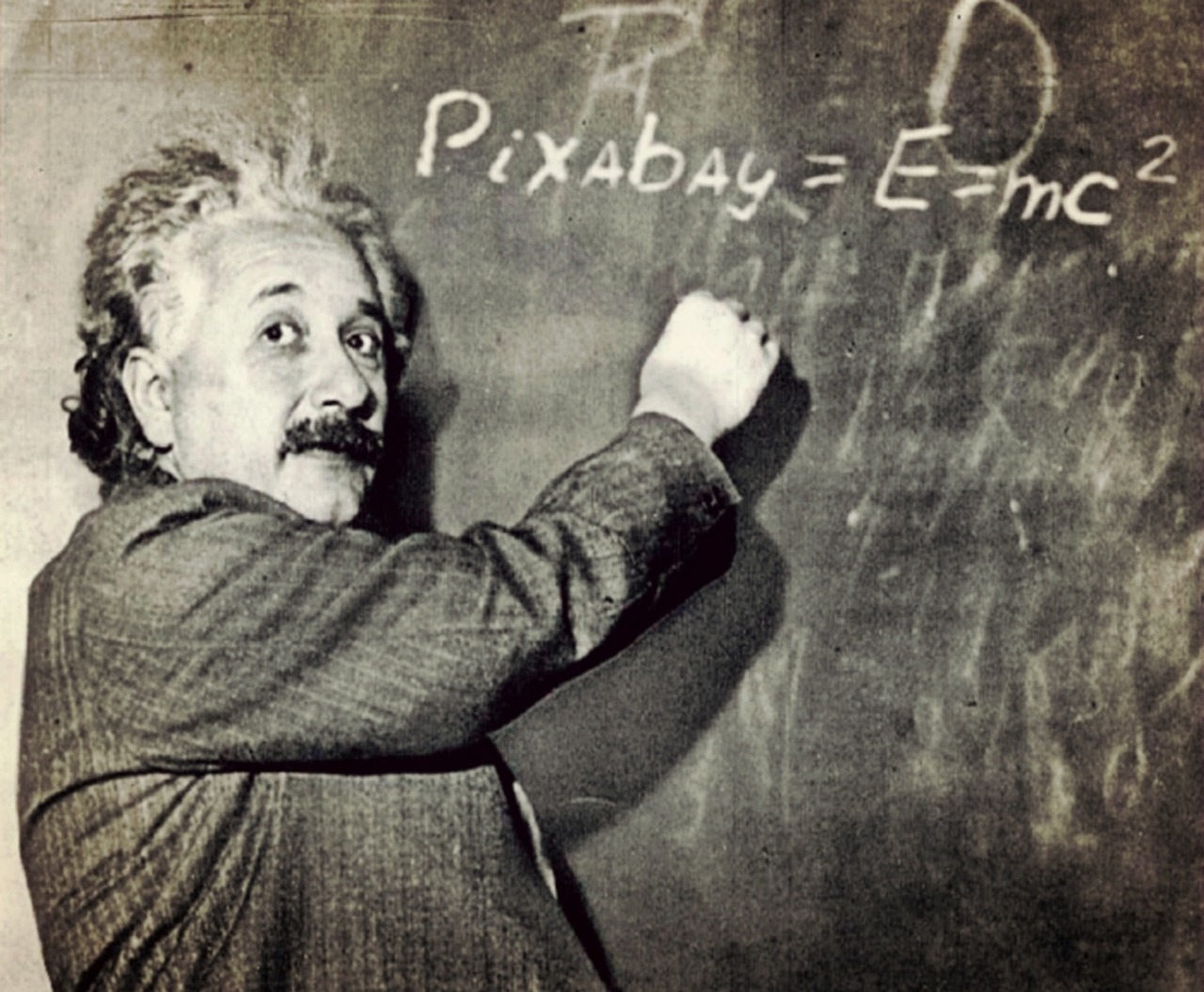
Gas Laws
The gas laws play a crucial role in supporting John Dalton's atomic theory, providing empirical evidence for the behavior of gases and their relationship to atomic structure. These laws, which include Boyle's Law, Charles's Law, and Avogadro's Law, offer insights into how gases behave under various conditions. Understanding these laws is like peering into the very essence of matter itself—revealing the intricate dance of atoms as they move and interact.
Boyle's Law states that the pressure of a gas is inversely proportional to its volume when the temperature is held constant. This relationship can be expressed mathematically as P1V1 P2V2, where P represents pressure and V represents volume. Imagine squeezing a balloon; as you reduce its volume, the pressure inside increases. This law illustrates how atoms in a gas compress and expand, reinforcing Dalton's idea that they are indeed tiny, moving particles.
On the other hand, Charles's Law highlights the direct relationship between the volume of a gas and its temperature when pressure is kept constant. This can be represented by the formula V1/T1 V2/T2, where V is volume and T is temperature in Kelvin. Picture a hot air balloon: as the air inside heats up, it expands, causing the balloon to rise. This expansion indicates that the atoms are gaining energy and moving more vigorously, again supporting Dalton's theory of atomic behavior.
Lastly, Avogadro's Law asserts that equal volumes of gases, at the same temperature and pressure, contain an equal number of molecules. This principle is fundamental in understanding the stoichiometry of chemical reactions. It can be summarized as V/n k, where V is volume, n is the number of moles, and k is a constant. This law reinforces the idea that atoms combine in specific ratios, aligning perfectly with Dalton's postulates.
In summary, the gas laws not only validate Dalton's atomic theory but also enhance our understanding of the microscopic world of atoms. They serve as a bridge between observable phenomena and the underlying atomic interactions, allowing chemists to predict how gases will behave under different conditions. The consistent behavior of gases, as described by these laws, emphasizes the importance of atomic theory in the broader context of chemistry.
- What are the main gas laws? The main gas laws include Boyle's Law, Charles's Law, and Avogadro's Law, each describing different relationships between pressure, volume, and temperature of gases.
- How do gas laws support Dalton's atomic theory? Gas laws provide empirical evidence that supports the idea that gases consist of atoms that behave predictably under various conditions, reinforcing the concept of atomic interactions.
- Can gas laws be applied in real-life scenarios? Yes, gas laws have practical applications in various fields, including meteorology, engineering, and even cooking, where understanding gas behavior is essential.

Law of Multiple Proportions
The is one of the cornerstones of Dalton's atomic theory, and it elegantly illustrates how different elements can combine in various ways to form multiple compounds. This law states that when two elements combine to form more than one compound, the masses of one element that combine with a fixed mass of the other can be expressed as simple whole-number ratios. Imagine two dancers on a stage, each with their own unique moves; when they come together, they can create a myriad of beautiful routines, each distinct yet based on the same foundational steps.
To better understand this concept, let’s take a closer look at an example involving carbon and oxygen. These two elements can combine to form different compounds, such as carbon monoxide (CO) and carbon dioxide (CO2). If we analyze the masses of carbon that combine with a fixed mass of oxygen, we find striking ratios:
| Compound | Mass of Carbon (g) | Mass of Oxygen (g) | Ratio of Carbon to Oxygen |
|---|---|---|---|
| Carbon Monoxide (CO) | 12 | 16 | 12:16 or 3:4 |
| Carbon Dioxide (CO2) | 12 | 32 | 12:32 or 3:8 |
This table highlights how the same mass of carbon (12 grams) can combine with different amounts of oxygen to form distinct compounds, showcasing the beauty and precision of chemical interactions. The ratios of the masses of oxygen that combine with a fixed mass of carbon (16 grams for CO and 32 grams for CO2) reveal a simple relationship: for every 3 grams of carbon, 4 grams of oxygen combine to form carbon monoxide, while 8 grams of oxygen are needed for carbon dioxide. It's like having a recipe where the ingredients can be adjusted, yet the essence of the dish remains intact.
Dalton's law not only provided a systematic way to understand chemical combinations but also paved the way for future scientists to explore the relationships between different elements. It emphasized the idea that atoms are not just random particles; rather, they possess unique identities and behaviors that dictate how they interact with one another. This concept was revolutionary, as it allowed chemists to predict the outcomes of reactions and to understand the fundamental principles governing the formation of compounds.
In summary, the Law of Multiple Proportions serves as a vital link in the chain of atomic theory, illustrating how elements can unite in various ways to create a multitude of substances. This law is a testament to the intricate dance of atoms, where each combination tells a story of its own, leading to the rich tapestry of chemistry that we continue to explore today.
- What is the Law of Multiple Proportions?
This law states that when two elements form more than one compound, the ratios of the masses of one element that combine with a fixed mass of the other can be expressed as small whole numbers. - How does this law relate to Dalton's atomic theory?
The law supports Dalton's idea that atoms combine in specific ratios, highlighting the distinct identities and behaviors of different elements. - Can you give an example of the Law of Multiple Proportions?
Yes! A classic example is the relationship between carbon and oxygen, which can form carbon monoxide (CO) and carbon dioxide (CO2), showcasing different mass ratios of oxygen that combine with a fixed mass of carbon.

Legacy of John Dalton
John Dalton's legacy is nothing short of monumental in the realm of chemistry. His atomic theory not only provided a solid foundation for understanding the nature of matter but also paved the way for numerous scientific advancements that followed. Imagine a world where we had no idea what atoms were; Dalton's work turned that uncertainty into a structured framework that scientists could build upon. His theories led to the classification of elements, which is essential for modern chemistry, and influenced the creation of the periodic table—a tool that every chemistry student and professional relies on today.
Moreover, Dalton's ideas extended beyond mere theory; they encouraged a wave of experimentation that sought to further unravel the mysteries of atomic behavior. His concept of unique atomic weights allowed chemists to predict how different elements would interact, leading to groundbreaking discoveries in chemical bonding and reactions. For instance, without Dalton's assertion that atoms combine in specific ratios, we might still be fumbling in the dark, trying to understand why certain substances react while others do not.
As we delve deeper into the legacy of Dalton, it's essential to recognize the lasting impact of his work on subsequent scientific fields. His atomic theory laid the groundwork for:
- The Development of Quantum Mechanics: Dalton's concepts were crucial in shaping the theories that led to quantum mechanics, allowing us to explore the behavior of atoms at a subatomic level.
- Advancements in Chemical Engineering: Understanding atomic interactions has led to innovations in chemical processes and materials science, making modern technology possible.
- Biochemistry: Dalton's work also influenced the study of biological molecules, helping scientists understand the chemical basis of life.
In addition to these contributions, Dalton is remembered for his meticulous approach to scientific inquiry. He was not just a theorist; he was an experimentalist who believed in the power of observation and evidence. His work demonstrated that scientific knowledge is built incrementally, through careful experimentation and validation. This principle remains a cornerstone of scientific methodology today.
In summary, John Dalton's legacy is a testament to the power of curiosity and the quest for knowledge. His atomic theory transformed our understanding of the universe at its most fundamental level, and its influence can still be felt across various scientific disciplines. As we continue to explore the intricacies of matter, we owe a great deal to Dalton's pioneering spirit and unyielding dedication to the pursuit of truth in science.
1. What is John Dalton best known for?
John Dalton is best known for developing the atomic theory, which posits that matter is composed of indivisible atoms, each with unique properties.
2. How did Dalton's work influence modern chemistry?
Dalton's work laid the foundation for the periodic table and influenced the understanding of chemical bonding and reactions, shaping the future of chemistry.
3. What were some key postulates of Dalton's atomic theory?
Key postulates include the indivisibility of atoms, the uniqueness of atomic weights for each element, and the conservation of mass in chemical reactions.
4. Did John Dalton conduct any experiments?
Yes, Dalton conducted various experiments, including those related to gas laws and the law of multiple proportions, which supported his atomic theory.
Frequently Asked Questions
- What is John Dalton known for?
John Dalton is best known for his pioneering work in atomic theory. He proposed that all matter is composed of tiny, indivisible particles called atoms, fundamentally changing the way we understand the composition of substances and chemical reactions.
- What are the key postulates of Dalton's atomic theory?
Dalton's atomic theory includes several key postulates:
- All matter is made up of atoms, which are indivisible and indestructible.
- Atoms of a given element are identical in mass and properties.
- Compounds are formed when atoms of different elements combine in fixed ratios.
- In chemical reactions, atoms are rearranged but not created or destroyed.
- How did Dalton's theory impact modern chemistry?
Dalton's atomic theory laid the groundwork for modern chemistry by providing a clear framework for understanding chemical reactions and the behavior of matter. It influenced future research, leading to the development of the periodic table and advancements in quantum mechanics.
- What experimental evidence supported Dalton's atomic theory?
Dalton's atomic theory was supported by various experiments, including the gas laws (like Boyle's and Charles's laws) and the law of multiple proportions, which demonstrated the consistent behavior of gases and the ratios in which elements combine to form compounds.
- What is the law of multiple proportions?
The law of multiple proportions states that when two elements combine to form more than one compound, the masses of one element that combine with a fixed mass of the other can be expressed as small whole numbers. This law provided crucial evidence for Dalton's atomic theory.
- What was Dalton's contribution to atomic weights?
Dalton introduced the concept that each element has a unique atomic weight, allowing for the classification of elements and a better understanding of how they combine in chemical reactions. This idea was essential in developing the modern periodic table.
- Why are Dalton's ideas still relevant today?
Dalton's ideas remain relevant because they established fundamental principles of chemistry that are still taught and used in scientific research today. His work paved the way for future discoveries, making him a cornerstone in the field of chemistry.






